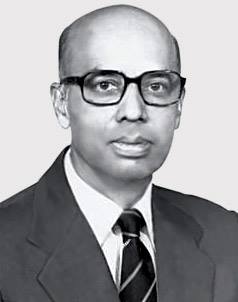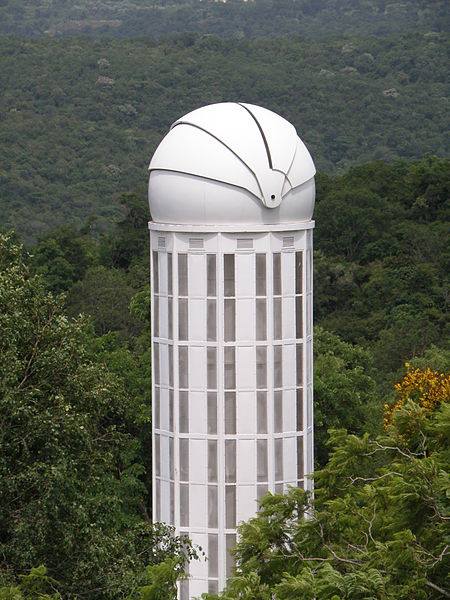MK Vainu Bappu: The Only Indian to Have a Comet & an Asteroid Named After Him
Thanks to his extensive contribution in the field of astronomy, Bappu earned one of the biggest honours in the astronomical community when he became the President of the International Astronomical Union for the years 1979-1982.

“I learnt astronomy in the lap of my father,” MK Vainu Bappu, the father of modern Indian astronomy, was often heard saying.
Born in 1927 to Manali Kukuzhi Bappu and Sunanna, Bappu was an alumnus of St. Annie’s Convent and Islamia High School. He completed his Bachelor’s in Science in 1946 and Masters in Physics from Nizam’s College, Hyderabad in 1949.
The young boy was fascinated with the cosmos thanks to his astronomer father who worked at the Nizamiah Observatory, Hyderabad.
Accompanying his father, Bappu quickly learned the ‘ins’ and ‘outs’ of telescopes and other instruments at the observatory.

In 1946, he published his first paper on variable stars in a journal, Current Science. He followed it up with another short paper in 1948 focusing on the spectrum of night airglow using a spectrometer he had built himself.
When Bappu wanted to pursue astronomy after completing his MSc, India lacked institutions offering courses. And he, finances. But a chance meeting in Hyderabad with the renowned astronomer and Harvard University professor, Harlow Shapley, changed the course of his life. Impressed by Bappu’s intelligence, the professor promised to put in a good word for him at Harvard. With the aid of a scholarship from the government of the erstwhile state of Hyderabad, Bappu enrolled in Harvard University in 1949.
Thanks to his extensive contribution in the field of astronomy, Bappu earned one of the biggest honours in the astronomical community when he became the President of the International Astronomical Union for the years 1979-1982.
The only Indian to have a comet named after him

Have you ever been fascinated by comets? Did you know Bappu is the only Indian to have a comet named after him?
On 2 July 1949, when Bappu was clicking pictures of the night sky, he spotted a bright moving object which he had rightfully understood to be a comet. When he turned to his professor, Bart Bok, and colleague Gordon Newkirk, they confirmed the discovery. They calculated the orbit of the comet which revealed that the comet would reappear only after 60,000 years!
The International Astronomical Union officially named the comet as the Bappu-Bok-Newkirk comet (C/1949N1). Bappu also received the Donohoe Comet Medal of the Astronomical Society of the Pacific.
Unfortunately, on the other hand, Indian diplomats from the country’s embassy in Washington DC apparently sent him a ‘severe warning’ advising him to concentrate on his PhD rather than ‘waste’ time looking for comets on a government scholarship.
Wilson-Bappu Effect
As part of his PhD thesis, Bappu carried out spectroscopic studies of a class of stars known as the Wolf-Rayet. This earned him the prestigious Carnegie Fellowship and the opportunity to work on the then-largest telescope in the US, the 200-inch Hale Telescope at Mount Palomar.
It was at this time that he worked with fellow astronomer Olin Chaddock Wilson to discover what would later be called the Wilson-Bappu Effect.
The duo conducted a spectroscopic analysis of late-type stars. Their study revealed that the width of emission lines of ionised calcium (Ca II K-line) in the chromosphere of stars was proportional to their absolute luminosity. This discovery became a tool to determine the distance of remote stars and study their chromosphere.
A paper was published in the Astrophysical Journal of the American Astronomical Society in 1957, and the discovery came to be known as the Wilson-Bappu Effect.
You May Also Like: How ‘Golden’ Girl Mirabai Chanu Smashed Barriers to Lift India to New Heights!
Leaving job offers to contribute to India

Bappu gave up several job offers in Europe and the US, even one from Harvard and chose to return to his homeland. As a student, he did not know of any astronomy courses or modern observational facilities in India so he decided to build institutions that could fill this gap.
After a fellowship with the National Science Academy, Bappu was appointed the Chief Astronomer at the Uttar Pradesh State Observatory in Varanasi.
He shifted the observatory to Manora Peak, a hilly location near Nainital at the foothills of the Himalayas stating Varanasi wasn’t suitable for an optical observatory due to city pollution. He not only equipped the observatory with the best instruments but also trained young astronomers to take the work forward.
Bappu then moved on to become the Director of the biggest solar observatory in Kodaikanal at the age of 32, after Prof. A.K. Bappu retired. He wanted the solar observatory to extend its work to stellar observations too. He selected a 40-acre land in a sandalwood forest near the village of Kavalur in Tamil Nadu to start a stellar observatory.
By 1967, they had built a 38-cm telescope to kickstart stellar observations.
In 1972, a 102-cm telescope from Carl Zeiss, Germany, was purchased and installed in the observatory, thanks to Bappu. His dedication reflects in how, he and A.P. Jayarajan, a specialist in optical instrumentation, learned German before the German engineers arrived. Why? To learn everything about maintaining the telescope and carry out repairs in the future.
This telescope helped astronomers at Kavalur discover the existence of an atmosphere in the Jovian satellite Ganymede and also confirm the rings around Uranus. Bappu’s dream of building a large stellar observatory in India was soon going to be realised.
He had openly supported the establishment of an autonomous organisation for astronomy. And in 1971, the Indian Institute of Astrophysics was established of which Bappu was founder Director.
One of the most ambitious projects he proposed was a 234-cm telescope. Yes, it was expensive. So, he worked meticulously with teams from across the country to cut costs.

They decided to import only the mirror blank. Specialists in different parts of India did everything else (e.g. grinding the block to make a parabolic concave mirror, design, and construction of the telescope mount, etc). It was also decided that the observatory would be open to all Indian astronomers.
In May 1974, the mirror blank weighing four tonnes arrived from Germany. The optical experts at the IIA started the grinding work towards the end of 1979. The civil construction of the telescope building at Kavalur had begun.
Everything was on track when tragedy struck, Bappu suffered a severe heart attack and had to undergo emergency bypass surgery at Munich. He developed a complication and passed away four days before he was supposed to address the 18th General Assembly of the International Astronomy Union (IAU) in Patras, Greece.
As sadness took over the entire astronomical society, his team at IIA worked even harder to fulfil his last wish of building the 2.34-meter stellar telescope at Kavalur.
Finally, the then Prime Minister Rajiv Gandhi inaugurated the telescope named the Vainu Bappu Telescope in the the Vainu Bappu Observatory on 6 January 1986. To commemorate the contribution of Bappu, the IAU, in its 19th General Assembly in New Delhi, named an asteroid: 2596 Vainu Bappu, after him
(Edited by Saiqua Sultan)
Information sourced from Science Reporter.
Like this story? Or have something to share?
Write to us: [email protected]
Connect with us on Facebook and Twitter.
If you found our stories insightful, informative, or even just enjoyable, we invite you to consider making a voluntary payment to support the work we do at The Better India. Your contribution helps us continue producing quality content that educates, inspires, and drives positive change.
Choose one of the payment options below for your contribution-
By paying for the stories you value, you directly contribute to sustaining our efforts focused on making a difference in the world. Together, let's ensure that impactful stories continue to be told and shared, enriching lives and communities alike.
Thank you for your support. Here are some frequently asked questions you might find helpful to know why you are contributing?


This story made me
-
97
-
121
-
89
-
167














